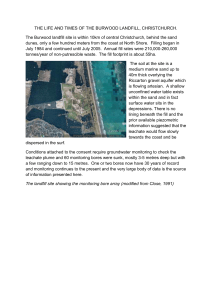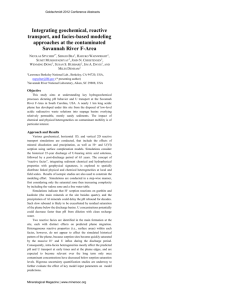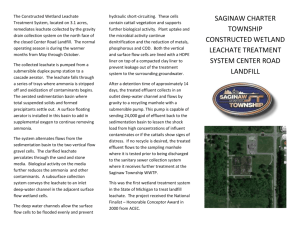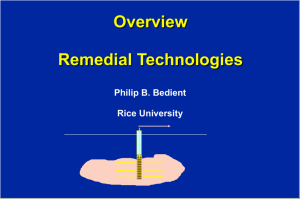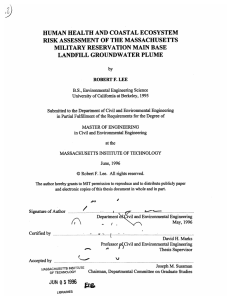Topic Biogeochemical transport modelling of natural attenuation
advertisement
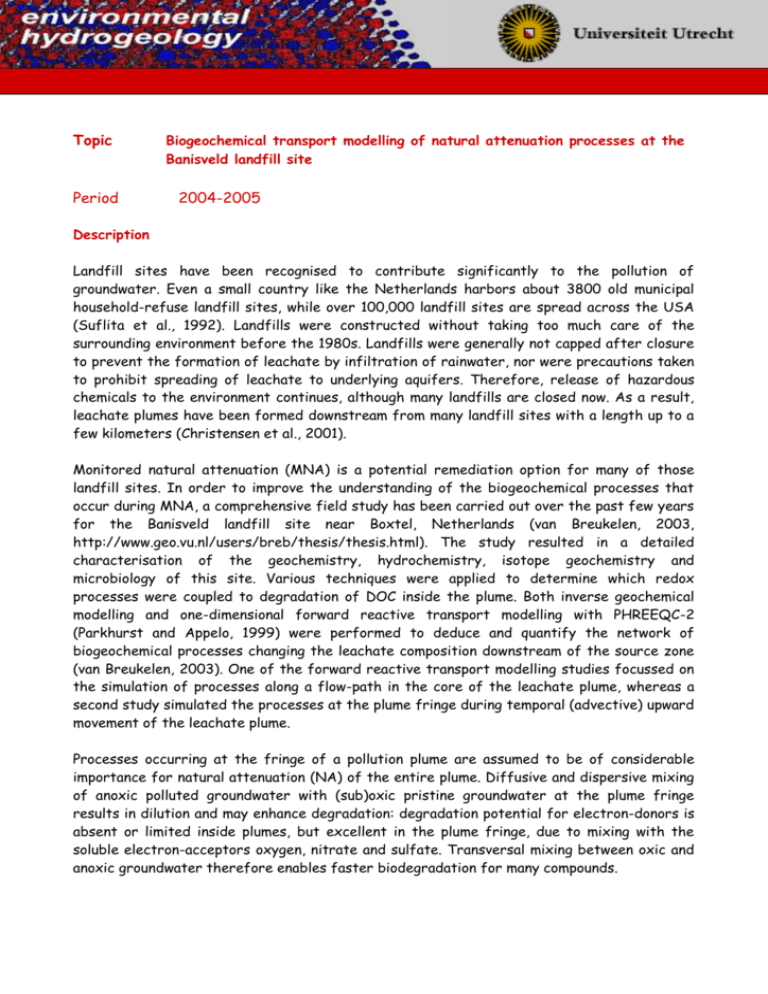
Topic Period Biogeochemical transport modelling of natural attenuation processes at the Banisveld landfill site 2004-2005 Description Landfill sites have been recognised to contribute significantly to the pollution of groundwater. Even a small country like the Netherlands harbors about 3800 old municipal household-refuse landfill sites, while over 100,000 landfill sites are spread across the USA (Suflita et al., 1992). Landfills were constructed without taking too much care of the surrounding environment before the 1980s. Landfills were generally not capped after closure to prevent the formation of leachate by infiltration of rainwater, nor were precautions taken to prohibit spreading of leachate to underlying aquifers. Therefore, release of hazardous chemicals to the environment continues, although many landfills are closed now. As a result, leachate plumes have been formed downstream from many landfill sites with a length up to a few kilometers (Christensen et al., 2001). Monitored natural attenuation (MNA) is a potential remediation option for many of those landfill sites. In order to improve the understanding of the biogeochemical processes that occur during MNA, a comprehensive field study has been carried out over the past few years for the Banisveld landfill site near Boxtel, Netherlands (van Breukelen, 2003, http://www.geo.vu.nl/users/breb/thesis/thesis.html). The study resulted in a detailed characterisation of the geochemistry, hydrochemistry, isotope geochemistry and microbiology of this site. Various techniques were applied to determine which redox processes were coupled to degradation of DOC inside the plume. Both inverse geochemical modelling and one-dimensional forward reactive transport modelling with PHREEQC-2 (Parkhurst and Appelo, 1999) were performed to deduce and quantify the network of biogeochemical processes changing the leachate composition downstream of the source zone (van Breukelen, 2003). One of the forward reactive transport modelling studies focussed on the simulation of processes along a flow-path in the core of the leachate plume, whereas a second study simulated the processes at the plume fringe during temporal (advective) upward movement of the leachate plume. Processes occurring at the fringe of a pollution plume are assumed to be of considerable importance for natural attenuation (NA) of the entire plume. Diffusive and dispersive mixing of anoxic polluted groundwater with (sub)oxic pristine groundwater at the plume fringe results in dilution and may enhance degradation: degradation potential for electron-donors is absent or limited inside plumes, but excellent in the plume fringe, due to mixing with the soluble electron-acceptors oxygen, nitrate and sulfate. Transversal mixing between oxic and anoxic groundwater therefore enables faster biodegradation for many compounds. The proposed thesis project is aimed at integrating the existing one-dimensional modelling studies into a single reactive transport model under consideration of a more realistic, multidimensional flow field. Particular attention will subsequently be given to the analyses of the role that vertical transverse dispersion plays for the evolution of the leachate plume and its (natural) attenuation. Objectives (i) Construction of a two-dimensional, cross-sectional flow model using MODFLOW (ii) Formulation of a suitable reaction module for the reactive multi-component reactive transport model PHT3D (Prommer et al., 2003, http://www.pht3d.org) (iii) Construction of a transport model with PHT3D (iv) (Re-)calibration of model parameters with the parameter estimation tool PEST (http://www.sspa.com/pest/) using the measured vertical concentration profiles from multilevel sampling devises (MLS) for both, organic and inorganic chemicals. (v) Analysis of the modelling results – (a) determination of parameter sensitivity (b) identification and quantification of major attenuation processes and (c) determination of the role of transversal dispersion on rates of natural attenuation. (vi) Comparison of results with similar ongoing studies of the EU project CORONA (http://www.shef.ac.uk/corona) Candidates For this MSc – project we are looking for a motivated student with a background in hydrology or geochemistry. Contact & information The project will be supervised by Phil Ham (ham@geo.uu.nl), Henning Prommer (UU/visiting scientist at CSIRO Australia; Henning.Prommer@csiro.au), and Dr. Boris van Breukelen (Vrije Universiteit Amsterdam).

